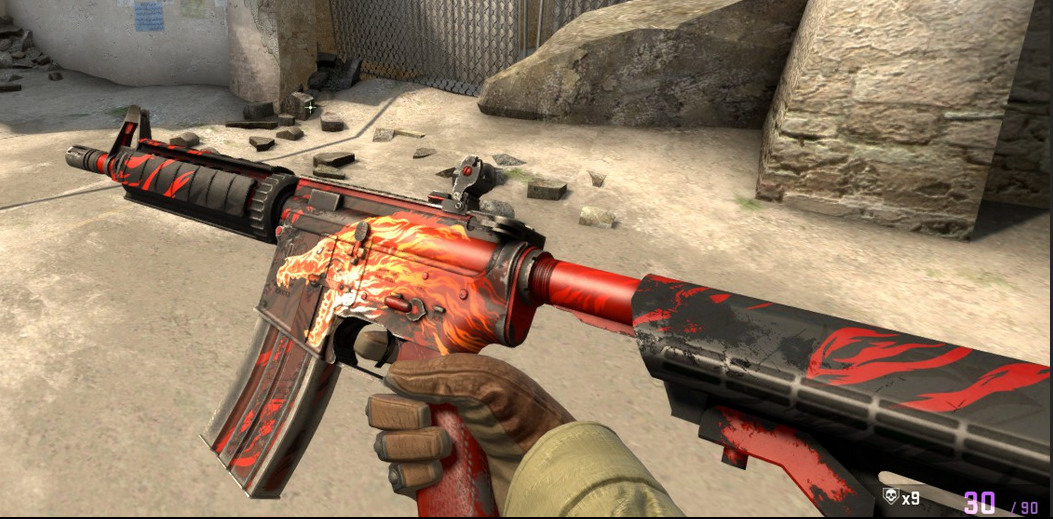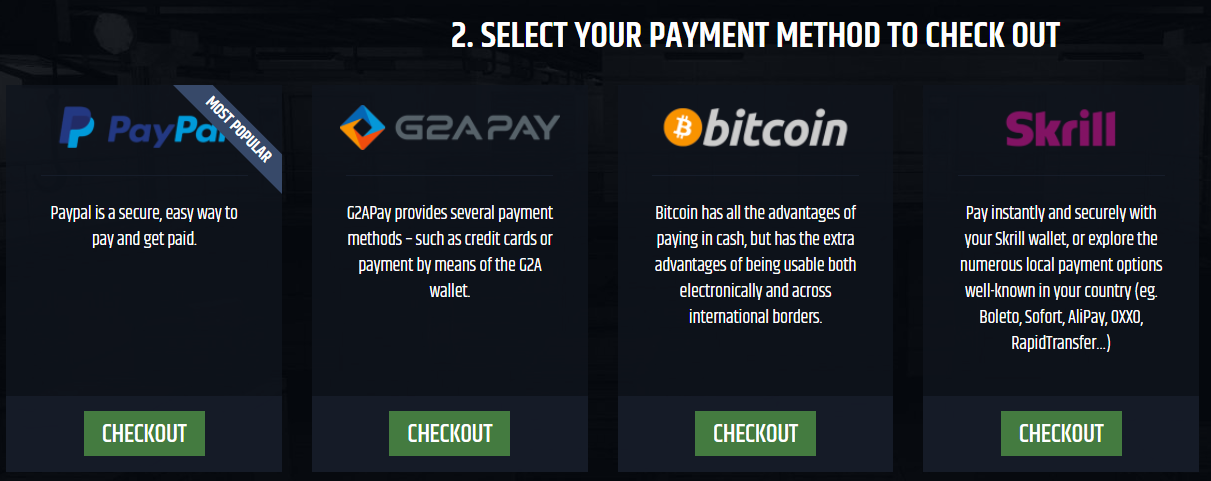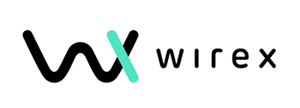Unknown market. How trade in in-game items became a sphere with a multi-million dollar turnover

Computer games have long gone beyond the limits of geek culture and turned into an industry with multi-million annual turnover. Of course, the lion’s share of the developers ’profits comes from direct sales of their games, but there are a number of online projects of various content that provide in-game purchases for monetization.
Conventionally, all games that are designed to spend hard earned money can be divided into several categories. So, conditionally, there are games:
')
- no system for the exchange of items between players (1st category);
- with the system of exchange of items between players (2nd category).
The two models described above somehow lead to additional monetization of the project and are characteristic of both paid games and unsuited MMO or shareware projects. To understand the bulky structures described above, it’s worth giving a couple of examples. In addition, we will try to follow the logic of various developers, analyze the pros and cons of the financial models they have created and what all this translates into for our wallets.
1st category of games
The most popular is the first model mentioned by us among the games monetized through the Free-to-Play system. This category mainly includes mobile games and a number of MMO-projects. The most famous similar game in our latitudes is the title project of Wargaming World Of Tanks, however, like the rest of the franchise games. In such games, all financial flows pass exclusively through the creators of the game, who sell in-game goods or services (bonuses) only directly. Any schemes with the transfer of property from account to account are technically absent, and the EULA text restricts the account holder to his game assets and prohibits the transfer or sale of an account to third parties.
On the one hand, such an approach makes it easier for developers to analyze the needs of the gaming audience, while at the same time making it possible to predict the intensity of financial flows. On the other hand, the participation of players in the financing of such games through the purchase of in-game property results in the latter getting a “liabilities”, which falls on the account “dead weight” even without the possibility of redistributing expenses at least part of the amount by legal means without significant losses. Of course, the developers of PC games leave the opportunity to sell the property for a part of the in-game currency, but only with a certain commission up to 50% of the amount.
In this case, purchased items do not necessarily give an advantage over the players. For example, Blizzard in its latest projects began to actively trade in "cosmetic" improvements along with Valve. So, in Hearthstone it is proposed to buy character icons, and in Heroes of the Storm and Overwatch - skins for heroes. And you need to understand that OverWatch itself, unlike the other projects mentioned, also needs to be bought separately, which seems to symbolize the degree of Blizzard greed.
Separately, in the same series are mobile games, the very essence of which does not provide for interaction with the community and, accordingly, the exchange of something other than links to the game in social networks. Making payments in such games, the user irrevocably loses his money, which, “entering” the project at the time of enrollment, completely depreciate in the outside world.
In general, the gaming industry in this regard is more like a black hole: honest game projects and platforms with the possibility of legal withdrawal of funds from the ecosystem are trivial. Those that offer to "earn" in the game are more financial pyramids than real games.
2nd category of games
Liberalization is achieved at a time when, in addition to the purchase of property, the administration allows them to legally exchange it within the game, it does not matter whether it is a game currency or items. Such projects are few, but they are the most humane in terms of the players managing their property. These can include multiple MMORPGs, in which the classic culture of markets has developed. For at least some regulation of cash flow, the developers resort to the old, but effective trick: the creation of nominal objects that can not be transferred.
According to this system, most of the popular projects are now working, in which in-game items are of material value, and Valve has become a trendsetter with its Steam Trading Platform.
Examples include games like CS: GO, Dota 2 and Team Fortress 2 from Valve. We can say that the alpha test of the existing model of cosmetic skins was performed on the TF2 platform, and already within the framework of Dota 2 and CS: GO they were released. According to some reports, the purchase and sale of in-game items in Dota 2 and CS: GO provided almost half of Valve’s four billion capital (50% of which belongs personally to founder Gabe Newell). It is possible that the developers did not even know what the creation of cosmetic items with a different chance of loss would lead to.
Unreal things and real millions
Online games are an amazing area where people can leave hundreds, and sometimes thousands and tens of thousands of dollars for fun. Many of the readers now come to mind stories about the cost of accounts in the old "Fight Club" or ships in EVE Online (which is still well). However, ten years ago, people paid money for quite a tangible advantage over other players, and at times they still pay. The very concept of cosmetic items would seem absurd: who would pay for a set of useless pixels? However, it is the ability to exchange these items, a different chance of their loss (both paid and free), as well as the excitement of gamers and their desire to stand out and created a whole shadow industry of online business.
As early as the beginning of 2017, a large sports publication ESPN published a longrid titled “Skins in the Game” , which colorfully talked about the “tote” system based on case studies in CS: GO, of which for $ 2.49 you can pull a random item out of a predetermined list (depending on the case series). The author of the publication provided stunning statistics: the turnover of CS: GO in-game items for 2016 is $ 5 billion.

Rifle worth from $ 700 to $ 1200, depending on the "worn"
But the rules of the Steam Marketplace do not allow withdrawing money outside the store's ecosystem, and the figure given by the author of the article many times exceeds the turnover possible within its framework. It was this restriction that created the whole industry on the “shadow” purchase and sale of in-game items, for which users were willing to pay much more than the maximum at the moment $ 400 (the official ceiling of the value of the item put on the site). It was the existence of a demand for a painless withdrawal of money outside of Steam with the ability to buy an in-game item inside the store's ecosystem and created a whole host of various intermediaries and "trading platforms" outside of it.
As such, intermediaries in the "shadow" transactions with in-game property, bypassing the rules of developers - the phenomenon is not new. For example, one of the oldest “shadow” gaming stores and part-time guarantor of transactions is the pwLVL resource with its subsidiary CashPass service. Why not make deals directly? Unfortunately, today the use of the services of such stores or guarantors is the only way to be sure that everyone will receive their own: the buyer is the property, and the seller is the money. Otherwise, with a probability close to one, one of the participants in the transaction will be deceived.
Since all such transactions take place in cyberspace, various electronic currencies are the most popular payment method. The scheme of work is simple: the seller provides the goods (transfers the item to the guarantor’s account or provides data from the account for authentication), and the buyer transfers the required amount to one of the guarantor’s electronic invoices. The latter carries out a reconciliation and after that gives the seller - the money, and the buyer - the property. Until recently, all this took place in the manual mode, and in the case of accounts, it still happens.
It should be noted that almost none of the intermediaries in this field accept payments through a plastic card. At the Russian sites, for example, at the same CashPass, it is proposed to pay for the transaction through Yandex.Money, Webmoney or QIWI Wallet, and in the west PayPal is popular. If we look at specific foreign sites, then on opskins.com - the resource mentioned in the ESPN material, PayPal is accepted as the currency of the G2A trading platform, the Skrill payment aggregator works, and bitcoins are accepted. On the motivation to receive the latter is to tell more.

Top up methods on opskins.com
As we all know, Bitcoin guarantees the anonymity of the payer, for it has no boundaries and jurisdictions. At the same time, a significant part of the players are minors. Of course, using the example of opskins.com we can say that they require ticking “I confirm that I turned 18” during registration, but in fact this fact cannot be verified. In the case of the shadow market of in-game items, BTC has become, if not a panacea, then a serious help for those who want to hide their real age or do not want to use conventional payment systems at all. Especially when it comes to purchases, the cost of which can reach several thousand or even tens of thousands of US dollars. Understandably, without a confirmation of the account, no payment system will miss such a transaction, but Bitcoin is fine. Of course, this field of application of cryptocurrency does not add respect to it, but once again shows its versatility.
We do not recommend using the services of the above-mentioned services for the sale and exchange, as their activities violate the terms of any User Agreement in any project!
What will happen next
The system of in-game values acquired for real money is an integral part of the modern gaming industry. This market is not limited to Valve projects or the Steam platform - many developers, ranging from the creators of faceless Korean MMORPGs and ending with Microsoft with their relatively recent acquisition in the form of MineCraft, somehow pull money from gamers' wallets.
The “gray” market of in-game currencies, items and accounts will continue to exist, because it was generated by the very concept of a standard User Agreement: the player does not have full control over the property in the account and is, in fact, a tenant. No developer wants to lose the potential profits that such control promises, along with the power and the very possibility of safely closing the project. After all, if the in-game property becomes legally, and not conditionally, the property of the players, then if the game is stopped supporting, any users will be able to sue the developer and demand compensation for the damage caused to him. Such a scenario would mean the death of the entire industry of online projects with a similar monetization model: only projects that work on a subscription system or a one-time purchase of the game will survive without the possibility of additional infusions of funds.
From one side, the existing state of affairs is beneficial for absolutely everyone except the end user: the developers reserve control over everything that happens in their project, the “shadow” schemes for the sale and cash out of game money live on their commission of a few percent. To say more - the "shadow" sector stirs up the players' interest in obtaining expensive items and indirectly brings huge profits to game developers, and it does not matter whether these values are obtained through in-game gold farm and earnings come from selling subscriptions, or by opening case studies of $ 2, 49 apiece. To dispute this statement does not even make sense, because the developers who make it possible to exchange in-game values, do not take any measures to combat the phenomenon of selling them for real money on third-party sites. Those projects whose financial flows are completely tied to the developer's cash desk, as is the case, for example, with World Of Tanks, take measures only after the transaction is completed and simply block the sold accounts under the guise of being hacked.
No one is going to cut the branch on which it sits. So in the future we are only expected to see the growing popularity of the “shadow” market described above, whose development keeps pace with the penetration of electronic money and Bitcoin into the daily life.

Source: https://habr.com/ru/post/400719/
All Articles